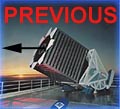Supplemental Exercise: Galaxy Collisions

Astronomer Chris Mihos and his colleagues from Case Western Reserve
University and the University of Oregon have written a free Java applet
that simulates interacting galaxies. Go to their web site by clicking
here.
Click Applet to launch the applet. A new window will open, and
the program will take a moment to load. Click Controls to launch a
small window describing the applet's controls. Change the angles of the
galaxies with respect to each other by clicking the dials with the left or
right mouse buttons. Change their separation distance by changing the "Peri"
variable. "Peri" is measured in kiloparsecs (kpc); 1 kpc = 3,200 light-years.
Change the mass of the red galaxy with respect to the green
galaxy by changing "Red Galaxy Mass."
If you don't see both galaxies in the window to the right, click Reset.
To start the simulation, click Start. You will see the two galaxies
interact in the right side of the window. The window also shows the
elapsed time in millions of years and the separation of the galaxies in
kiloparsecs (1 kiloparsec = 1000 parsecs = 3000 light-years). The graph at
the bottom shows the separation (pink) and the relative velocity of the
galaxies (blue) as a function of time.
Supplemental Exercise
1. Change the angles, initial separation, and initial masses
of the galaxies. Also try checking "friction," which turns on friction
in the simulation, and "big halos," which gives the galaxies large
dark matter haloes. Experiment by changing some of the parameters.
Have fun! |
Supplemental Question
1. What are the most important parameters for determining
what a galaxy interaction will look like? |
Supplemental Question
2. Can you design a simulation that will give you an output
that looks like the picture above? What parameters do you need to use? |
|

